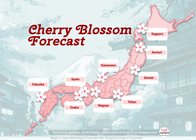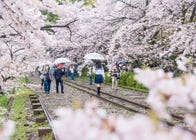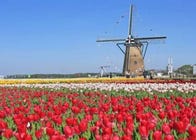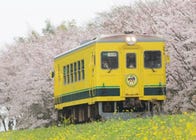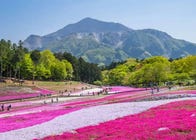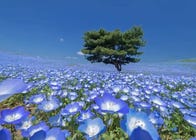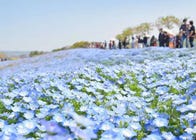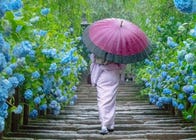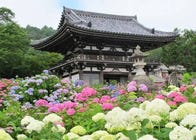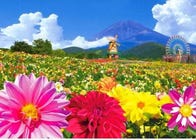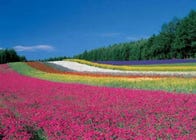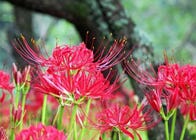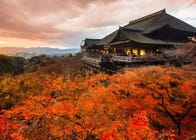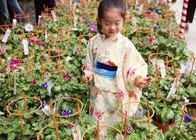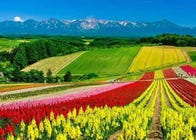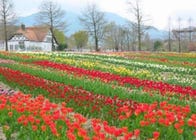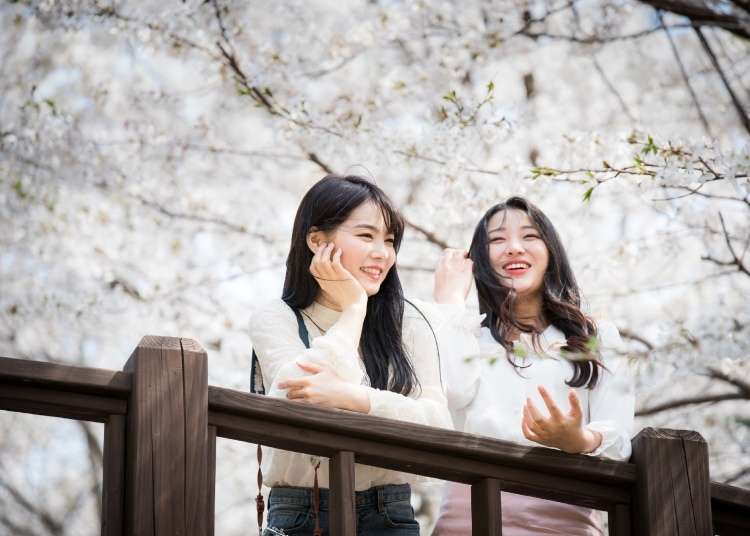
Getting to see the beautiful flowers in Japan is a wonderful experience, especially during spring and summer. If you are thinking of traveling to Japan, you may want to check out areas known for their Japanese gardens or even join a flower tour. These tours can include some of the most famous flowers in Japan, including cherry blossoms.
Wondering where and when you can see these beautiful Japanese flowers? Follow along as we introduce you to the flowers that bloom each month, tell you where to find them, and share links to tours that you can book.
Main image: PIXTA
Flowers of Japan: A special kind of culture
Flowers have a lot of meaning in this lovely country. Ikebana, or flower arranging, is one of the three classical Japanese arts of refinement. At the same time, rather surprisingly, Japan has a long history of tattooing, and Japanese flowers are a popular tattoo.
Meanwhile, there is no doubt that Japan is famous for sakura cherry blossoms, along with the whole concept of hanami (having a picnic and seeing cherry blossoms), so many tourists try to visit Japan to see them.
Clearly, there is something quite special and beautiful about Japanese flowers. It is perhaps an indicator of how deep flowering plants have penetrated the culture that visitors to Japan will want to visit a traditional Japanese garden, perhaps go to a flower park or festival, eat a sakura flavored KitKat or other sweet, and even sakura flavored sake.
Now that you know how important flowers are in Japan, you must be intrigued to know which flowers you can see in which season, but never fear, we have gathered all the information we could get to know exactly when which flowers are blooming!
Spring flowers in Japan
Whether you're a first-time visitor to Japan or a seasoned traveler, you'll want to visit during the spring flower season. In addition to cherry blossoms, there are many other attractive spring flowers to explore. From plum to wisteria, there are plenty of varieties to enjoy. You may also want to check out some of the popular flower festivals in Japan.
Plum (Ume) - Late February–Early March
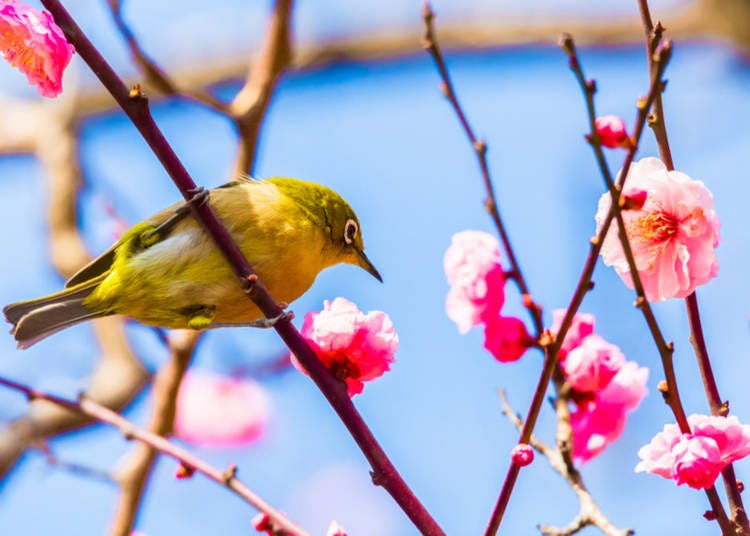
The first blossoming flower of spring is not actually cherry blossoms, but ume (plum) blossoms! Known as "ume" in Japanese, they are an important cultural symbol in Japan and are celebrated as one of the first signs of spring.
Plum blossoms have significant historical and cultural importance in Japan. They symbolize vitality, hope, and renewal as they bloom even in the harsh winter weather, indicating the advent of spring. Plum blossoms were even the preferred flower for "hanami" flower viewing festivities before cherry blossoms gained popularity.
Plums are also used to make various Japanese foods and drinks, such as umeboshi (pickled plums) and umeshu (plum wine).
- Kairakuen (Ibaraki Prefecture): Established by Tokugawa Nariaki, Kairakuen is a vast park with about 3,000 plum trees of over 100 varieties, spread across 58.0 hectares. Its name, meaning "a park to enjoy with people," embodies Nariaki's vision. The park is famous for its Plum Festival, held from mid-February to late March, drawing many visitors annually.
- Osaka Castle Park (Osaka Prefecture): This 105.6-hectare park, anchored by the historic Osaka Castle, is renowned for its plum blossoms. From mid-February, approximately 1,270 plum trees of 100 varieties bloom, offering a unique display of multi-colored flowers on single trees and varied petal colors within individual blossoms.
- Sobetsu Park (Hokkaido): Spanning 8.6 hectares near Lake Toya, Sobetsu Park provides panoramic views of the surrounding mountains and lake. Its plum grove becomes a spectacle in May, with about 300 trees blossoming in pale pink, creating a stunning contrast with the fresh greenery and the blue of Lake Toya.
- Inabe City Agricultural Park (Mie Prefecture): In northern Mie Prefecture, this expansive park encompasses a plum grove with 4,000 trees across 100 varieties. Known as one of the largest plum groves in the Tokai area, the park becomes a sea of plum blossoms, offering visitors a magnificent spectacle.
- Iwamotoyama Park (Shizuoka Prefecture): Located in Fuji City, Shizuoka Prefecture, Iwamotoyama Park features 389 plum trees of 30 varieties. The park is a favorite among photographers for its stunning views of plum blossoms with Mt. Fuji in the backdrop. The blossom peak in February and March is celebrated with various events.
- Yushima Tenjin Shrine (Tokyo): Yushima Tenjin Shrine, located in Tokyo, is celebrated for its beautiful plum blossoms. Revered as a site of academic blessings, the shrine's plum garden blooms vibrantly each spring. The plum blossom festival held here is a cultural highlight, attracting visitors seeking both natural beauty and spiritual solace.
- Atami Plum Garden (Atami): In the coastal city of Atami, Atami Plum Garden is a renowned destination for plum blossom viewing. The garden boasts a selection of 469 trees across 60 varieties, which bloom in a cascade of colors. It's especially popular for its early-blooming plum trees, making it a unique spot for early spring visits.
Japanese Cherry (Sakura) - Late March–Early April
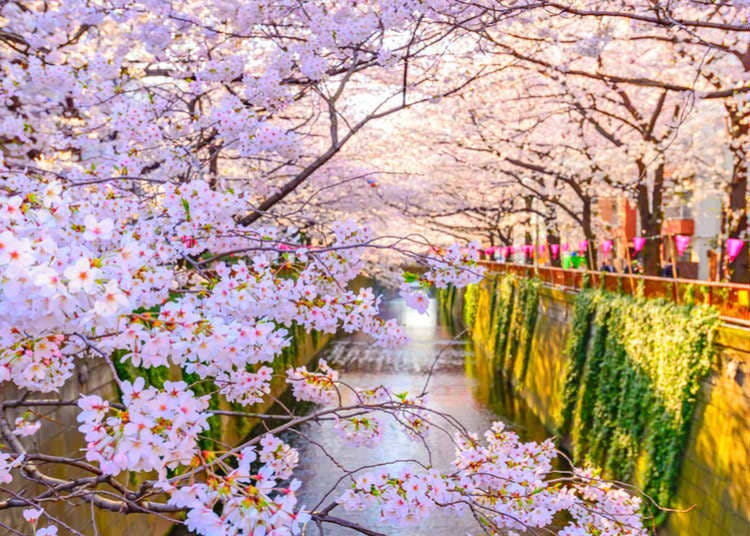
Any list of Japanese flowers wouldn’t be complete without mentioning sakura cherry blossoms! This flowering tree has become so famous that the news reports on the blossom forecast across Japan, and people across the whole country find time to enjoy hanami.
Although all cherry blossoms have some shared characteristics, there are significant variations within the Japanese cherry tree flower (sakura) family. If you take a closer look, you will notice differences in color, shape, size, and more. While most Japanese sakura blossoms are pale pink, they can also be white, dark pink, or even yellow!
Japan is known to have more than 200 types of cherry trees, including both wild and cultivated varieties. Check out our article here to learn more about when and where you can enjoy these beautiful flowers.
Significance: Cherry blossoms, or sakura, symbolize the transient beauty of life in Japanese culture. Hanami, or flower viewing, is a popular activity during this season.
- Mt. Yoshino (Nara Prefecture): Known as Japan's most famous cherry blossom spot, Yoshino features around 30,000 sakura trees. The whole mountain turns pink during peak bloom, creating a breathtaking view.
- Ueno Park (Tokyo): A prime spot for hanami, Ueno Park boasts around 1,200 cherry trees. The park's festive atmosphere during the cherry blossom season, with food stalls and picnickers, is iconic.
- Hirosaki Castle (Aomori Prefecture): With around 2,600 trees, the castle grounds offer a picturesque setting with moats, bridges, and traditional architecture framed by cherry blossoms.
- Chidorigafuchi (Tokyo): Famous for its cherry blossom tunnel along the moat of the Imperial Palace. Boat rides offer unique views of the blossoms from the water.
- Himeji Castle (Hyogo Prefecture): The magnificent white castle, a UNESCO World Heritage Site, is surrounded by around 1,000 cherry trees, making it a striking location for blossom viewing.
Wisteria (Fuji) - Late April–Early May
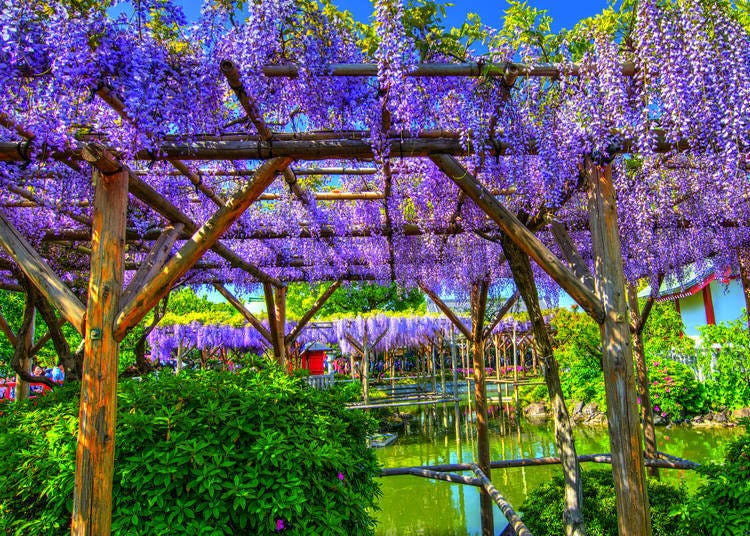
Wisteria is a flower highly regarded in Japanese culture for its association with good luck, kindness, and longevity. It has been a cherished flower in Japan for centuries, and it is prominently featured in literature, art, and cultural traditions.
In Japan, Wisteria is commonly known as "fuji." During the Heian period (794-1185), the color purple, which is the color of the wisteria flower, was exclusively reserved for royalty and the aristocracy.
Wisteria plants produce a cascade of flowers, up to 50cm long, and can have upwards of 100 flowers on just one tree. The Japanese wisteria is typically a pale purple or blue color and is cultivated by gardeners around the world. Japan is home to some of the most famous wisteria gardens in the world, some of which are mentioned below.
- Ashikaga Flower Park (Tochigi Prefecture): Gaining international attention from CNN's "2014 Dream Travel Destinations," this park is celebrated for its ancient 160-year-old Great Wisteria. Visitors can marvel at over 350 wisteria trees, including a tunnel of white wisteria and a vibrant yellow Kibana wisteria tunnel. The park is famous for its day and night views, with the nighttime illumination recognized as a Japanese night view heritage.
- Kasama Inari Shrine (Ibaraki Prefecture): As one of Japan's three major Inari shrines, it draws around 3.5 million visitors yearly. The shrine's grounds are graced with two ancient wisteria trees, each over 400 years old, and designated as natural monuments. The shrine complex also features the Kasama Inari Art Museum, showcasing historical pottery.
- Kameido Tenjin Shrine (Tokyo): Known for its scenic beauty, this shrine in Tokyo's downtown area has become a focal point for wisteria enthusiasts, with over 50 wisteria plants. The Wisteria Festival here is a lively event with numerous stalls and enchanting nighttime illuminations, with the Tokyo Skytree providing a striking backdrop.
- Yokosuka Shobuen (Kanagawa Prefecture): Notable for being one of Japan's largest iris gardens, it also includes a wisteria garden with 11 varieties of about 250 plants. The garden hosts a Wisteria Festival, where visitors can indulge in traditional Japanese sweets and tea while enjoying the floral displays.
- Fuji no Saku Oka Park (Tochigi Prefecture): This expansive area, covering about 2.3 hectares, is home to a 250-meter-long wisteria trellis and a garden showcasing 45 varieties of wisteria. The Fujioka Wisteria Festival features a range of activities, including markets, concerts, and stunning night illuminations.
- Kawachi Fujien Wisteria Garden (Fukuoka Prefecture): Kawachi Fujien is only open twice a year, for wisteria in spring and fall foliage in autumn. The garden is a visual feast with 22 varieties of wisteria, including the eye-catching Noda Long Wisteria and Lipstick Wisteria. The extensive wisteria trellises and tunnels measuring 110 meters and 80 meters, respectively, set against a backdrop of lush greenery, make for an unforgettable experience.
-
Ashikaga Flower Parkあしかがフラワーパーク
- Address 607 Hasama-cho, Ashikaga-shi, Tochigi 329-4216
-
Nearest Station
Tomita Station
- Phone Number 0284-91-4939
Hours: 10AM - 9PM
Tulips (Churippu) - Late April–Early May
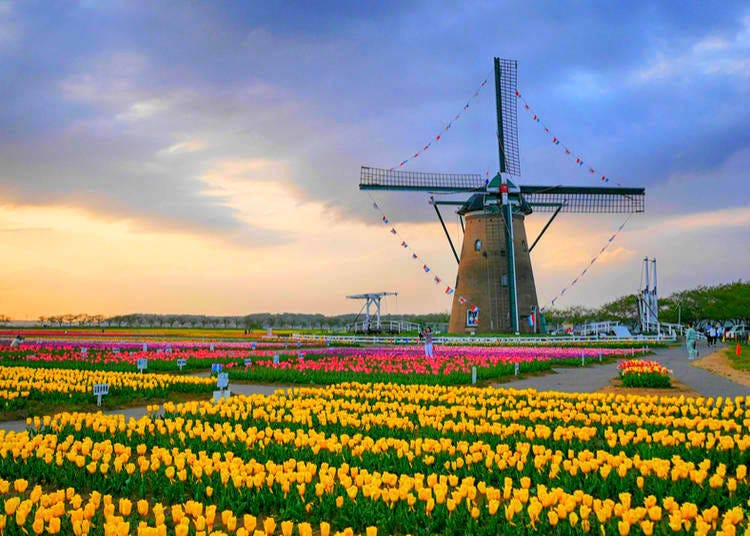
Tulips are widely considered to be one of the most common and popular flowers in Japan. They are often associated with perfection, profound love, and joy. The tulip was first introduced to Japan during the Edo period (1603-1868) through the country's relations with the Netherlands. Japan has several major tulip festivals and parks that showcase these beautiful flowers, some of which are mentioned below.
- Kamiyubetsu Tulip Park (Hokkaido): A vast park with around 200 tulip varieties spread over 70,000 square meters. The Tulip Fair in early May attracts many visitors. Features include a windmill-shaped observatory, giant wooden clog sculptures, and Dutch national costume rentals for photo opportunities. The park also offers guided tours on the electric bus "Tulipitt."
- Takino Suzuran Hillside National Park (Hokkaido): Hokkaido's only national park, covering about 400 hectares, offers a tulip area known as "Hana no Makiba." Other attractions include various flower gardens, large play areas, park golf, and fishing spots, along with a walk to the scenic Ashiribetsu Falls.
- Yukiyagawa Dam Forest Park & Karumai Tulip Garden (Iwate Prefecture): Situated along Yukitani River Dam Lake, this park blooms with about 150,000 colorful tulips from late April to mid-May. Highlights include a 16-meter-tall windmill observatory, a 154-meter-long red Memorial Bridge, and a festival featuring Erythronium japonicum blooms.
- Gunma Flower Park (Gunma Prefecture): Located at the foot of Mount Akagi, this park features diverse flowers, including 50 tulip species and 190,000 bulbs blooming from early April. It hosts year-round flower festivals and has family-friendly facilities like splash ponds and roller slides.
- Hitachi Seaside Park (Ibaraki Prefecture): Known for its seasonal flower fields, amusement park, and cycling courses, the park's spring season showcases stunning fields of daffodils and tulips, especially in the Tamago no Mori Flower Garden.
- Nasu Flower World (Tochigi Prefecture): Located in the Nasu Highlands, this park offers views of about 300 tulip varieties and 250,000 plants set against the Nasu mountain range. Nearby attractions include the Nasu Alpaca Farm and Nasu Animal Kingdom.
- Sakura Furusato Square (Chiba Prefecture): Hosts the Sakura Tulip Festa each spring, where around 100 tulip varieties and 700,000 plants bloom. The festa includes photo spots, local food booths, tulip bulb digging, and boat tours of Inba Marsh.
- Showa Memorial Park (Tokyo): A large park featuring a variety of facilities and a natural environment. The park showcases cherry blossoms in mid-March, followed by tulip blooms in late March, along with other spring flowers like rapeseed, azaleas, and poppies.
- Tanto Tulip Festival (Hyogo Prefecture): This spring event in the Tajima region showcases about 100,000 artistically arranged tulips and hosts a tulip sample garden with around 300 varieties. Activities include tulip picking, a photo contest, and a bazaar with local products.
- Akashi Kaikyo National Government Park (Hyogo Prefecture): Located on Awaji Island, this park is surrounded by flowers, greenery, and the sea. It features diverse flower fields, plant pavilions, playgrounds, restaurants, and accommodations. The spring tulips are among the largest in the Kansai region, with about 100 varieties and 200,000 plants.
-
Sakura Furusato Square佐倉ふるさと広場
- Address 2714, Usuita, Sakura-shi, Chiba 285-0861, Japan
- Phone Number 043-486-6000
Canola/Rapeseed (Nanohana) - Mid-March–Early April
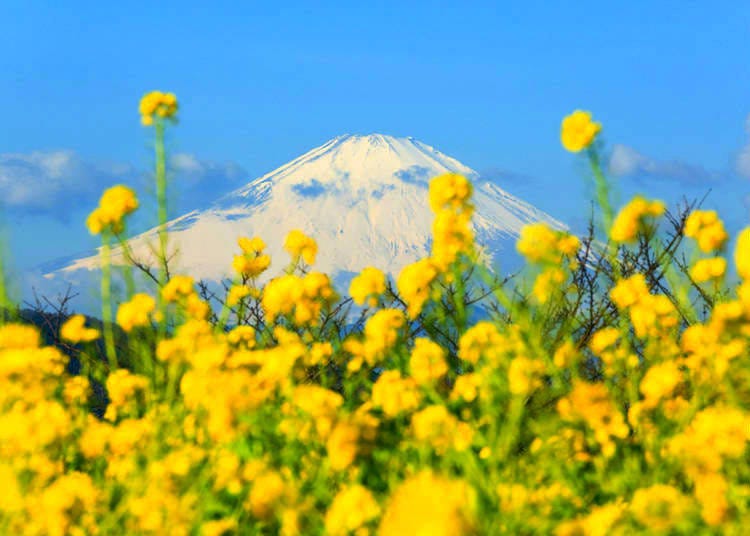
Canolas, also known as rapeseed or field mustard, are characterized by their bright yellow flower buds and greens that are harvested before the flowers fully bloom. In Japan, canolas are considered a seasonal delicacy that marks the arrival of spring. The young, tender greens and flower buds are commonly used in Japanese cuisine, often boiled and served with dashi (stock) and katsuobushi (bonito flakes). They can also be pickled, used in salads, or added to stir-fries and other dishes. In Japan, canolas are celebrated at flower festivals, where the bright yellow fields are enjoyed for their springtime beauty, often contrasted with the pink of cherry blossoms.
- Ebeotsu Hills (Hokkaido): The rapeseed fields around JR Hakodate Main Line’s Ebeotsu Station are celebrated for their beauty. Peak viewing occurs in late May, coinciding with the Takikawa Canola Flower Festival, which features local Hokkaido cuisine and rapeseed-based products. The fields’ changing appearance each year adds to their allure.
- Canola Blossom Fields in Yokohama Town (Aomori Prefecture): These extensive fields in Yokohama Town are known for their vast “carpet of yellow,” being Japan’s largest in terms of planting area. The rapeseed blooms in early May, with optimal viewing from mid to late May. The Nanohana Festival in mid-May offers scenic views, including Mutsu Bay and wind turbines among the fields.
- Moka Railway (Tochigi Prefecture): This unique non-electrified local line between Ibaraki and Tochigi Prefectures is known for its SL Moka steam locomotive. The picturesque combination of the train with cherry blossoms and rapeseed fields is a popular attraction, especially for photographers.
- Kasai Rinkai Park (Tokyo): Overlooking Tokyo Bay, this park features an aquarium, bird sanctuary, and various plazas. Its 240-meter cherry tree avenue and one of Tokyo’s largest rapeseed fields create stunning scenery, further enhanced by the giant Ferris wheel and Crystal View.
- Kominato Railway (Chiba Prefecture): A renowned spring destination in the Kanto region, it draws visitors for its picturesque rapeseed fields. The Ishigami rapeseed field, with retro trains passing through, offers a photogenic blend of rapeseed flowers, blue skies, and trains.
- Azumayama Park (Kanagawa Prefecture): Known for its early-blooming rapeseed flowers from January, the park’s summit offers panoramic views, including Sagami Bay and Mount Fuji, on clear days. The park’s light hiking trail is ideal for winter walks, providing a warming experience at the summit.
-
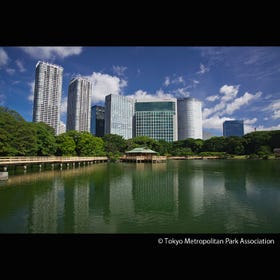
-
Address
Hamarikyuteien, Chuo-ku, Tokyo, 104-0046
View Map -
Nearest Station
Tsukijishijo Station (Toei Oedo Line)
5 minutes on foot
- Phone Number 03-3541-0200
-
Address
Hamarikyuteien, Chuo-ku, Tokyo, 104-0046
Moss Phlox (Shibazakura) - April–May
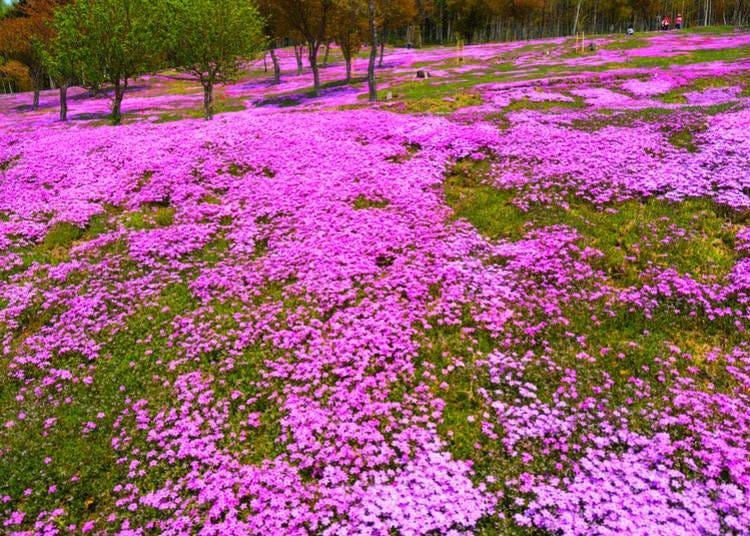
Shibazakura, also known as moss phlox or lawn cherry, is a stunning plant that blooms in spring in Japan. This plant is native to America and grows close to the ground, producing beautiful flowers. Shibazakura is highly prized in Japan for its striking, carpet-like appearance when in full bloom, which is reminiscent of cherry blossoms. There are several spots in Japan where you can enjoy the shibazakura, many of which hold annual festivals to celebrate the blooming of the moss phlox.
- Higashimokoto Shibazakura Park (Hokkaido): Known nationally for its extensive moss phlox fields, the park is a vast area covered in pink shibazakura. During the blooming season, it hosts events, including night illuminations, creating a fantasy-like atmosphere. The park also offers outdoor amenities like hot springs and camping, ideal for relaxing after flower viewing.
- Misato Shibazakura Park (Gunma Prefecture): Set against the backdrop of mountains in Takasaki City, this park's 3-hectare area is blanketed in pink moss phlox. Known for its beautiful shibazakura designs, the park's peak bloom period is early April to early May, highlighted by the annual "Misato Shibazakura Festival."
- Hitsujiyama Park (Saitama Prefecture): A premier destination for moss phlox, this park features over 400,000 plants in 10 varieties, offering splendid views of the Chichibu mountains. Visitors can enjoy various moss phlox designs during its peak season from mid-April to early May.
- Tokyo German Village (Chiba Prefecture): This natural park, inspired by German rural towns, hosts the Shibazakura Festival from late March to late April, where visitors can admire around 250,000 moss phlox plants. Its vibrant landscape and additional attractions make it a family-friendly destination.
- Fuji Motosuko Resort (Yamanashi Prefecture): Offering a unique combination of Mount Fuji and moss phlox, this resort hosts its Fuji Shibazakura Festival from mid-April to late May. The picturesque scenery is complemented by the Fuji Delicious Food Festa, enhancing the visitor experience.
- Shibazakura Park: Hana no Jutan (Hyogo Prefecture): Open only during the peak season from mid-April to early May in Sanda City, this garden's hills bloom with around 100 million moss phlox flowers, creating a stunning carpet of flowers. The pet-friendly garden is perfect for picnics, appealing to couples and families.
-
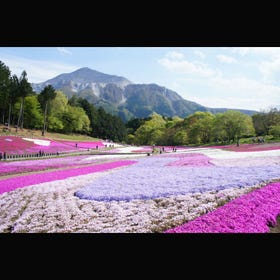
-
Address
6267, Omiya, Chichibu-shi, Saitama, 368-0023
View Map -
Nearest Station
Seibu-Chichibu Station (Seibu Chichibu Line)
15 minutes on foot
- Phone Number 0494-25-5209
-
Address
6267, Omiya, Chichibu-shi, Saitama, 368-0023
Nemophila/Baby Blue Eyes (Nemofira) - Mid-April–Early May
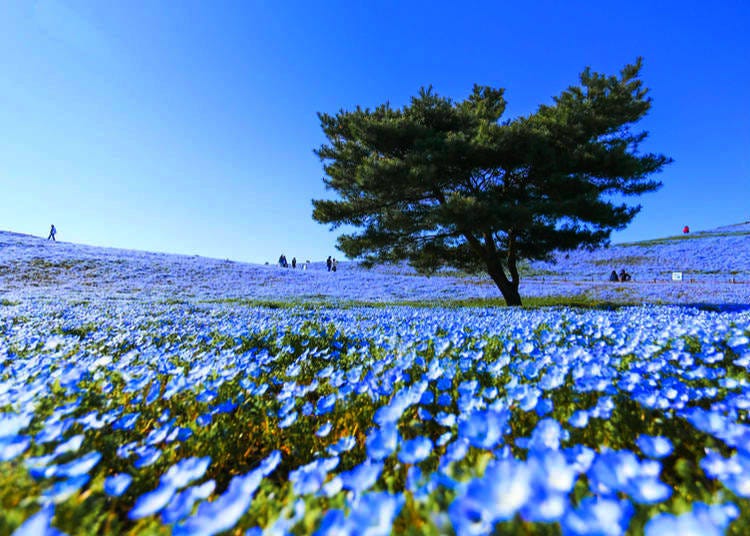
Nemophila, also known as "baby blue eyes," is a spring flower that is famous for its beautiful blue blossoms in Japan. Native to western North America, particularly California and Oregon, it is known for its bright blue, bowl-shaped flowers that bloom in April to May, just after the cherry blossom season. These popular ornamental plants are cultivated in several large fields in Japan, creating dreamy fields of color.
- Hitachi Seaside Park (Ibaraki Prefecture): Famous for its vast blue fields of Nemophila, the park draws crowds from mid-April to early May. The highlight is "Miharashi Hill," covered with about 4.5 million Nemophila, creating a stunning sea of blue. It's an accessible and popular spot for visitors of all ages to experience spring.
- Showa Memorial Park (Tokyo): This urban park in Tokyo combines natural beauty with seasonal flowers. Around 60,000 Nemophila bloom in the "Herb Hill" area from late April to mid-May. The park also offers a range of activities, making it ideal for those seeking both flower viewing and outdoor fun.
- Lake Yamanakako Hana no Miyako Park (Yamanashi Prefecture): Known for its panoramic views of Mount Fuji and a vibrant floral landscape. The park's vast flower fields create a picturesque setting, especially with the Nemophila and Mount Fuji backdrop during the bloom season from early May to mid-June.
- Osaka Maishima Seaside Park (Osaka Prefecture): As Western Japan's largest Nemophila destination, it boasts about 1 million Nemophila from mid-April to early May. The park offers a stunning blue gradient view alongside the sky and sea, with unique aerial views available through helicopter and paragliding experiences.
- Awaji Island Akashi Kaikyo National Park (Hyogo Prefecture): Located on Awaji Island, this park features a variety of flower beds and about 100,000 Nemophila from mid-April to early May. The flowers create an immersive blue environment, beautifully contrasting with the colorful tulips. The peak season also hosts the "Blue Island Party" with various engaging activities.
-
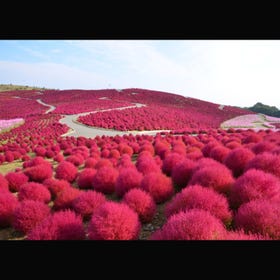
-
Address
605-4, Onuma, Mawatari, Hitachinaka-shi, Ibaraki, 312-0012
View Map -
Nearest Station
Katsuta Station (JR Joban Line / Hitachinaka Seaside Railway Minato Line)
-
Address
605-4, Onuma, Mawatari, Hitachinaka-shi, Ibaraki, 312-0012
Roses (Bara) - Early–Mid May
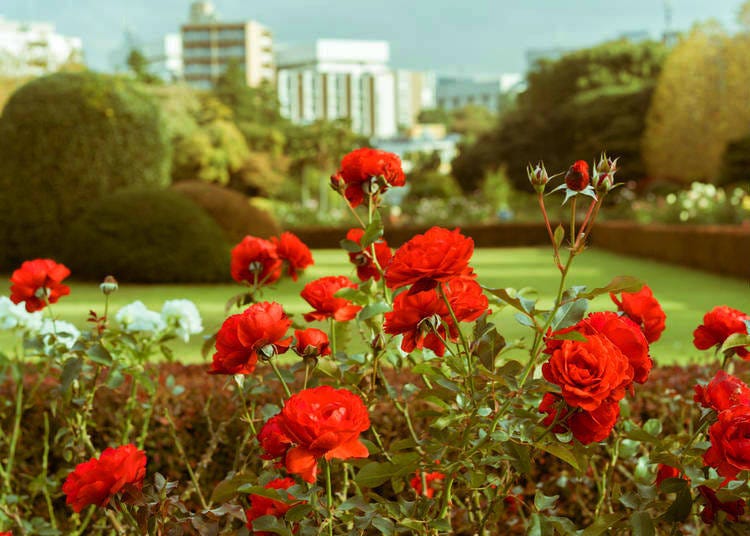
Roses, known as "bara" in Japanese, were originally imported from China and began being cultivated as a garden crop in the 12th century. In Japanese culture, roses are highly valued and are a popular symbol of the country's beautiful autumn season. European varieties of roses arrived in Japan later, and the postwar period saw the beginnings of the first rose exhibitions and rose societies in Japan. Today, there are many famous gardens and areas where roses can be enjoyed, including the ones mentioned below.
- Higashizawa Rose Park (Yamagata Prefecture): As the largest rose garden in Tohoku, this 7-hectare park boasts a colorful array of about 750 rose varieties and 20,000 plants. Visitors can enjoy rare roses, thematic walking paths, and unique attractions like the 'Rose Bell' and 'Rose Soft Cream.'
- Ibaraki Flower Park (Ibaraki Prefecture): This flower park offers a sensory experience with around 900 rose varieties, creating a vibrant spectacle. The best viewing times are in spring (mid-May to mid-June) and autumn (late September to early November), with various interactive activities available year-round.
- Keisei Rose Garden (Chiba Prefecture): One of Japan's leading rose gardens, it showcases about 1,600 varieties and 10,000 plants. The peak season in late May to early June features music events and photo contests. The garden also includes other floral attractions and dining facilities.
- Atami ACAO FOREST (Shizuoka Prefecture): Spanning 20 million square meters with sea views, this garden features 12 themed areas and about 600 rose varieties. Best viewed from May to June, the park offers guided tours, diverse activities, and scenic dining options like the COEDA HOUSE cafe.
- Nakanoshima Park Rose Garden (Osaka Prefecture): A prominent Kansai rose garden, offering a peaceful escape in the city. With around 310 varieties and 3,700 plants, it provides a stunning bloom during early summer and autumn. The garden's urban-natural blend and the illuminated night view make it a picturesque spot.
Poppies (Poppi) - April–Late May
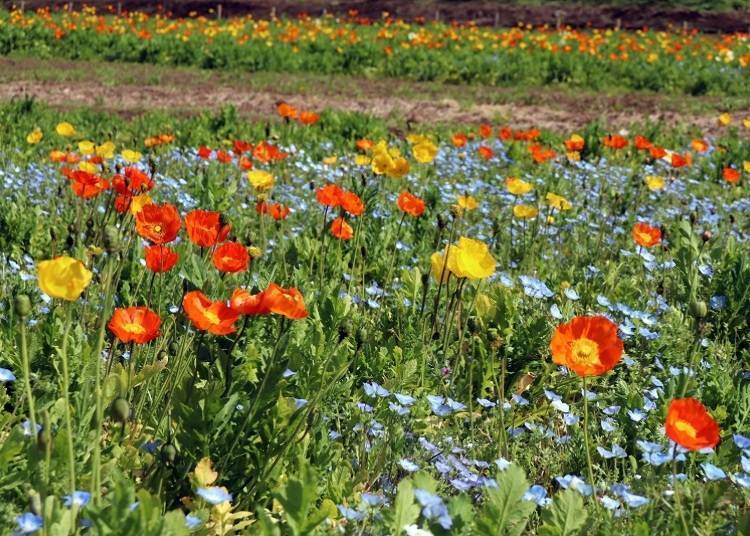
Poppies do not hold a particular significance in Japanese culture but are admired for their beauty at several locations throughout the country. During mid-spring, many large parks will open poppy fields to visitors. The colorful petals of the poppies create a stunning contrast against the blue sky and greenery, making it a sight worth seeing.
- Michinoku Lakeside Park (Miyagi Prefecture): Nestled against the Zao Mountain Range, this national park features vibrant pink poppies. The South District's poppy fields, covering about 3 million square meters, come alive with approximately 2 million poppies from mid to late May, offering an immersive floral experience.
- Kurihama Flower Park (Kanagawa Prefecture): In Yokosuka City, this park celebrates nature with a variety of seasonal blooms. During the "Poppy and Nemophila Season," visitors can enjoy over a million poppies of various types. The park also offers a range of activities, including park golf and bouldering, and is dog-friendly. The added convenience of a footbath makes it an excellent destination for a full day's outing.
- Awaji Hanasajiki (Hyogo Prefecture): Known for its dazzling spring scenery, the park's poppy season peaks from late April to mid-May. It features observation decks and beautifully designed flower beds, ideal for leisurely exploration in the quieter morning hours.
Summer flowers in Japan
During the summer season, Japan is full of flowers that make a great addition to any itinerary. The country has a rich tradition of flower viewing. Some of the best flowers in Japan include hydrangea, sunflowers, azaleas, iris, and lavender.
Japanese Iris (Hanashobu) - May–July
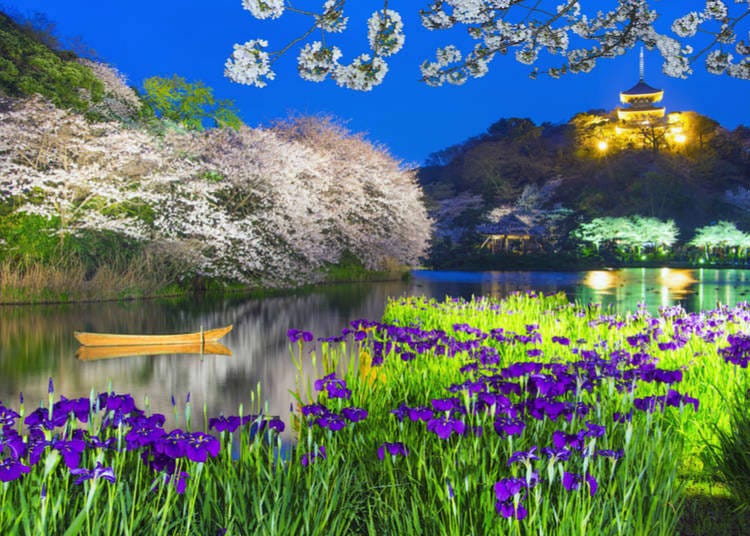
Hanashobu, also known as the Japanese iris, is one of the primary types of iris grown in Japan. In Japanese flower symbolism, they represent happy news, a gentle heart, and elegance. Hanashobu is a water-loving iris that grows in wetland areas. It is the most extensively cultivated variety of Japanese iris, with many different cultivars selected for gardens throughout Japan. Japanese irises usually bloom from early to late June, but depending on the area they can bloom as early as May. They come in shades of purple, including reddish-purple, and have a unique "vein" pattern on their petals, with a yellow streak in the center of the flower.
- Ayame Park (Hokkaido): This expansive park in Iwamizawa City boasts a breathtaking view of 168 varieties and about 150,000 Japanese irises, including Kakitsubata Irises, blooming from late June to July. The annual Saihaka Festival in July offers a leisurely flower viewing experience, and the park's observation deck provides an excellent vantage point for appreciating the full bloom.
- Suigo Itako Ayame Garden (Ibaraki Prefecture): A renowned spot in Itako City, Ibaraki, known for its 500 varieties and 1 million Japanese irises, including the Kakitsubata and Ayame varieties. The garden's unique experience includes boat rides through the waterways, offering a picturesque view of the floral landscape.
- Horikiri Shobuen (Tokyo): Located in Katsushika Ward, Tokyo, this garden is famous for its irises, with about 200 varieties and 6,000 plants. Visitors can observe the differences among the various species and enjoy the grand Katsushika Iris Festival held from early to mid-June.
- Suigo Sawara Ayame Park (Chiba Prefecture): Situated in Katori City, this park is a tranquil spot in the "water town" area. It boasts 400 varieties and 1.5 million plants of Japanese irises. For a complete experience, boat tours through the park are recommended.
- Meigetsu-in (Kanagawa Prefecture): Known as the "Hydrangea Temple" in Kamakura City, Meigetsu-in also features a stunning display of about 3,000 Japanese irises. The irises bloom in early June, offering a scenic view behind the "Window of Enlightenment."
- Odawara Castle (Kanagawa Prefecture): This popular tourist destination in Odawara City features a Japanese iris garden in its East Moat. Around 6,000 irises bloom in June, coinciding with the Odawara Castle Hydrangea and Iris Festival, which includes nighttime illuminations.
- Oshino Hakkai (Yamanashi Prefecture): A part of the UNESCO World Heritage site Mount Fuji, Oshino Hakkai in Oshino Village is a famous spring site. The "Shobu Pond" here is known for its legendary irises, offering a mystical view.
- Umami-kyuryo Park (Nara Prefecture): A historical park in Nara, known for its ancient burial mounds. Its iris garden, with about 100 varieties and 30,000 plants, attracts many visitors. The Umami Iris Festival in early June features various events, food stalls, and music stages.
-
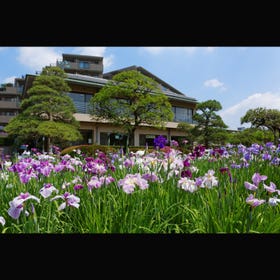
-
Address
2-19-1, Horikiri, Katsushika-ku, Tokyo, 124-0006
View Map -
Nearest Station
Horikiri-Shobuen Station (Keisei Main Line)
10 minutes on foot
- Phone Number 03-3697-5237
-
Address
2-19-1, Horikiri, Katsushika-ku, Tokyo, 124-0006
Lotus (Hasu) - Mid-July–Mid-August
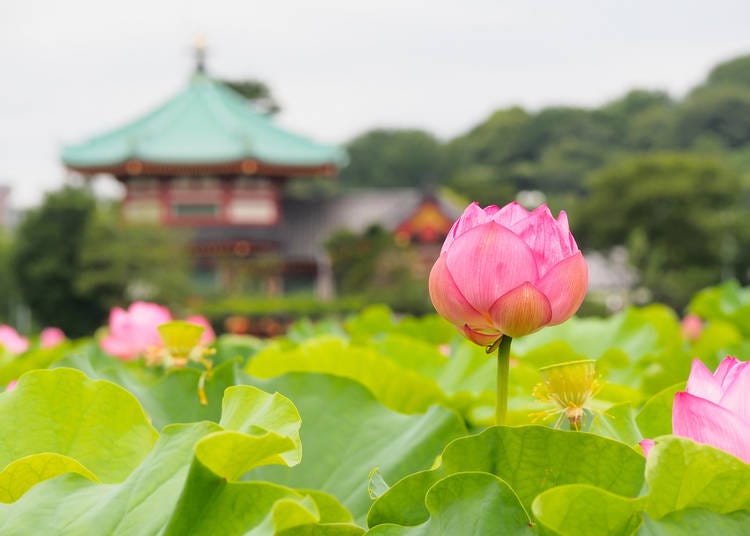
Lotus flowers can be found blooming in ponds and lakes throughout Japan from mid-July to mid-August. These beautiful flowers are known for their large and vibrant pink, red or white petals, which have an exceptional fragrance. In Japan, lotus flowers hold deep spiritual significance, rising from the mud and bloom into a beautiful flower, representing the journey from suffering to enlightenment. Apart from their spiritual meaning, lotus flowers are also used in Japanese cuisine. The roots of the lotus, known as renkon, are a popular ingredient in dishes like tempura and stir-fries.
- Izunuma-Uchinuma (Miyagi Prefecture): Famous as a wintering ground for swans, this area becomes a spectacle of lotus flowers from late July to mid-August. The sight of large swans flying overhead adds to the park's allure. During the annual 'Hasu Festival,' visitors can take boat tours to view the lotus flowers up close, making for a memorable experience.
- Ja no Hana Gardens (Fukushima Prefecture): Registered as a tangible cultural property, Ja no Hana Gardens is known for its exquisite art and precise carvings. In front of the building, the Suribachi Pond blooms with about 10,000 water lilies, creating a fantastical scenery. The park also features wisteria trellises and rose gardens, offering a variety of flowers throughout the year. Visitors can also enjoy barbecues by reservation.
- Shinobazu Pond (Tokyo): A natural pond in Ueno Onshi Park, known for its lotus-covered Hasu Pond. The pond transforms into a sea of lotus flowers from early July to late August. Visitors can enjoy boating, admire waterfowl, and take stunning photos with the Bentendo Hall in the background, making for a perfect SNS-worthy moment. The park is also a delight throughout the year with cherry blossoms, plum trees, and hydrangeas.
- Monet's Pond (Gifu Prefecture): Known for its clear spring water and colorful koi, this unnamed pond (nicknamed 'Monet's Pond') resembles a Monet painting. Located in front of a shrine in Gifu Prefecture, the pond's water lilies bloom in early summer. Visitors are advised to visit on sunny days for the best views when sunlight creates a picturesque scene reminiscent of Monet's artworks.
- Mizunomori Water Botanical Garden (Shiga Prefecture): Situated on the shores of Lake Biwa, this park hosts over 2,000 species of aquatic plants. Visitors can enjoy a variety of water lilies, lotus, and Paraguayan water lilies, with the pond changing its appearance monthly in summer. The Atrium houses important Buddhist trees like the Sala, Muyu, and Bodhi trees. The on-site restaurant offers lotus-themed dishes like lotus udon and lotus-flavored soft ice cream.
- Mimurotoji Temple (Kyoto Prefecture): Known as the 'Lotus Temple' and part of the ancient Pilgrimage of the Western Country, this temple, founded about 1,200 years ago, is a popular pilgrimage spot. The garden features a mix of karesansui and pond-style landscapes. In addition to the historical site of 'Ukifune' from The Tale of Genji, the temple is also famous for its flowers, including 20,000 azaleas in spring, 10,000 hydrangeas in early summer, and various unique lotus varieties like 'Daijakunishiki,' 'Oga Lotus,' and 'Ancient Lotus.'
-
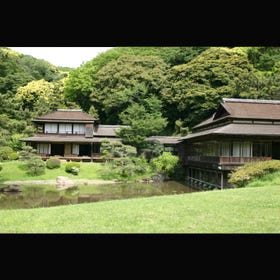
-
Address
58-1, Honmokusannotani, Naka-ku, Yokohama-shi, Kanagawa, 231-0824
View Map -
Nearest Station
Negishi Station (JR Negishi Line)
10 minutes by bus
- Phone Number 045-621-0634
-
Address
58-1, Honmokusannotani, Naka-ku, Yokohama-shi, Kanagawa, 231-0824
Sunflowers (Himawari) - July–August
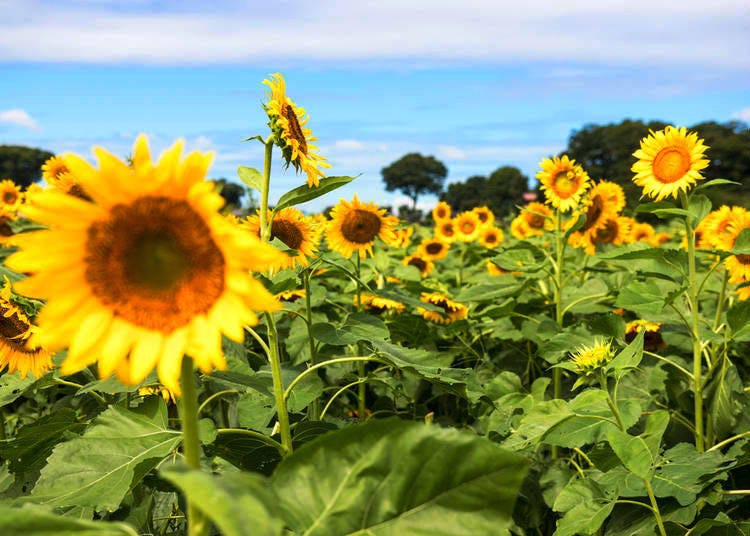
Sunflowers, called "himawari" in Japanese, are a very popular flower in Japan. They bloom in the summer months, typically from late July to mid-August, and there are many famous sunflower fields and festivals across the country during this time. Sunflowers have become a symbol of hope and recovery in Japan, seen as also representing happiness, positivity, luck, and longevity in Japanese culture.
- Sunflower Fields in Ozora Town (Hokkaido): Spanning various locations in Ozora Town around Memanbetsu Airport, these sunflower fields bloom from late July to early October. Asahigaoka Park offers long-lasting blooms, while the area north of the airport provides unique views of airplanes amid sunflowers. The Tomappu River Park showcases the striking contrast of sunflowers with lush greenery.
- Koriyama Nunobiki Kaze-no-Kogen (Fukushima Prefecture): At an altitude of 1,000 meters, this highland offers views of sunflower fields, Mount Bandai, and Lake Inawashiro. Known for its white wind turbines amidst yellow sunflowers, the highland presents a picturesque scene, especially during clear days and misty mornings.
- Yamanakako Hananomiyako Park (Yamanashi Prefecture): Near Lake Yamanaka, this highland park is covered with sunflowers on a 300,000 square meter area in summer, offering stunning views against the backdrop of Mount Fuji.
- Nagisa Park (Shiga Prefecture): Along Lake Biwa, the park is home to 12,000 sunflowers spread over 4,000 square meters. The park's scenic beauty is enhanced by the backdrop of Lake Biwa and the Hira Mountains, providing an ideal setting for sunflower viewing.
- Sunflower Hill Park (Hyogo Prefecture): With 500,000 sunflowers blooming in mid-July, the park features attractions like the Sunflower Tower, seasonal flower beds, and a children's playground. The park also includes a fresh vegetable market and a local products shop, making it a perfect destination for both relaxation and exploration.
Hydrangea (Ajisai) - Mid-June–Mid-July
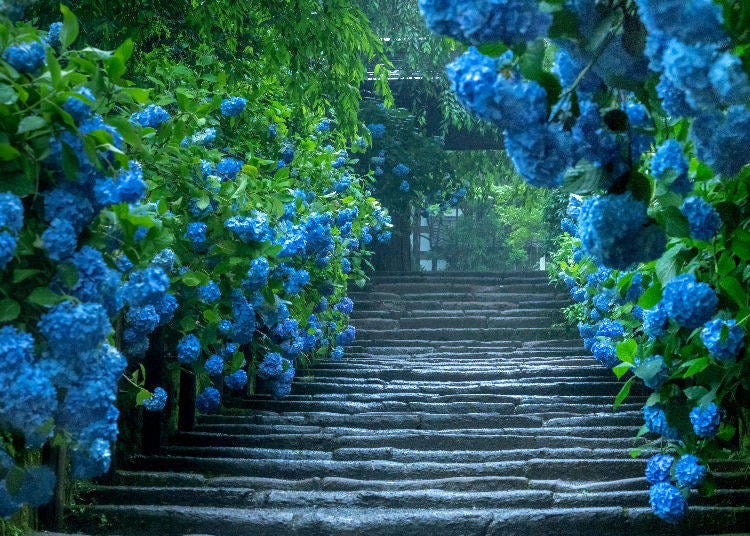
Hydrangeas, also known as "ajisai" in Japanese, are believed to have originated in Japan and other parts of Asia. Ancient Japanese literature from the Nara period (710-784) mentions these flowers. They usually flower from May to July, reaching their peak in June during the rainy season known as tsuyu. There are more than 30 different types of hydrangeas that can be found in Japan. Notably, the leaves of the Hydrangea serrata variety are used to brew amacha, a sweet tea traditionally consumed during the Buddha's birthday celebrations. Throughout June and July, hydrangea festivals are commonly held across Japan.
- Michinoku Hydrangea Garden (Iwate Prefecture): A top hydrangea destination in Tohoku, opening around early July. The garden, with a 2km path through a cedar forest, boasts about 400 varieties and 40,000 hydrangea plants, offering a serene forest bath experience.
- Unsho-ji Temple (Akita Prefecture): Famous for its stunning blue hydrangeas in Oga City, the temple's unique cultivation produces a dense, carpet-like bloom. The sight of hydrangeas against the backdrop of North Ura's port and Oga's sea, especially when illuminated at night, is breathtaking.
- Hase-dera Temple (Kanagawa Prefecture): This historic temple in Kamakura, known for its year-round floral beauty, showcases splendid hydrangeas during the rainy season, adding charm to the traditional Kamakura visit.
- Hakone Tozan Railway (Kanagawa Prefecture): Known for its hydrangea-lined route, peaking in mid-June. The "Hydrangea Train" journey offers picturesque views, particularly enchanting on rainy nights with illuminated blooms.
- Mishima Skywalk (Shizuoka Prefecture): Boasting Japan's longest pedestrian suspension bridge, this attraction features a hydrangea path with 13,000 plants and 205 varieties. Visitors can also enjoy adventurous activities and animal interactions, making it a diverse and pet-friendly destination.
- Kazahaya no Sato (Mie Prefecture): Set within Ise Onsen Golf Club, this garden displays 39 varieties and 75,000 hydrangea plants across 25,000 square meters. The creatively designed hydrangea areas, like the 'Hydrangea Flower Clock,' offer stunning views.
Lavender (Rabenda) - Early July–Early August
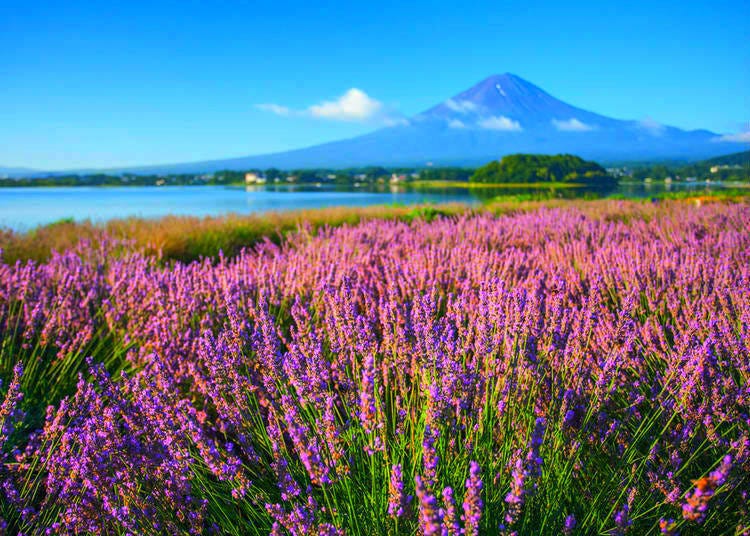
Lavender is cherished and iconic in Japan, particularly on Hokkaido, the northernmost island. Introduced for cultivation in the 1940s, lavender began as an agricultural product but evolved into a major tourist draw as cheaper imports became available. While lavender will grow in other regions of Japan, like Nagano and Gunma, Hokkaido is now the premier location to view breathtaking lavender fields. The Furano region, in the heart of Hokkaido, is particularly famous for its extensive lavender fields, which are at their most spectacular from late June through early August.
- Farm Tomita (Hokkaido): As one of Japan's largest lavender fields, Farm Tomita offers stunning purple vistas against the Tokachi mountains. Peak bloom occurs from late June to late July, where visitors can enjoy walks through the lavender fields and try lavender-flavored treats.
- Abukuma Caves Lavender Garden (Fukushima Prefecture): This garden, famous for its 50,000 lavender plants, reaches peak bloom from early June to early July. Popular for lavender picking and its unique lavender soft ice cream, it's a delightful spot for a scenic walk.
- Tambara Lavender Park (Gunma Prefecture): Situated at 1,300 meters on the Tambara Plateau, this park features around 50,000 lavender plants with an expansive view, especially from its observatory. Offering a variety of lavender types and a range of activities, it's an ideal destination for a full day of enjoyment.
Dahlias (Daria) - Mid-July–Early October
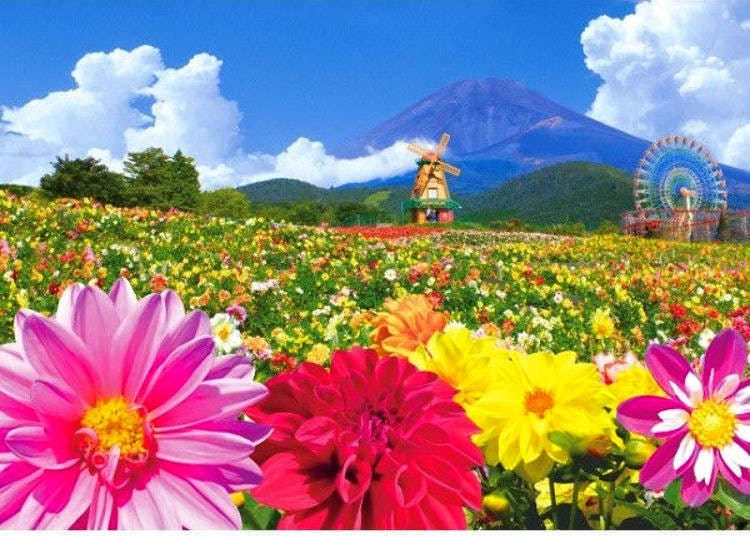
Dahlias, originally from the high plains of Mesoamerica, particularly Mexico, are not native to Japan. Nonetheless, Japanese breeders have created numerous distinctive varieties. Known for their vivid colors and unique forms, dahlias have become a celebrated part of Japanese horticulture. Japan boasts several famous dahlia gardens and festivals, highlighting the nation's fondness for these vibrant flowers.
- Akita International Dahlia Garden (Akita Prefecture): This garden showcases around 700 dahlia varieties from 14 countries, offering a world-class display during full bloom. Its dahlias, known for their variety and beauty, are cultivated for distribution nationwide.
- Kawanishi Dahlia Garden (Yamagata Prefecture): One of Japan's largest tourist dahlia gardens, it features 650 varieties and 100,000 plants over 4 hectares. Known for its diverse and vibrant dahlias, the garden also offers local specialties and hosts various events from August to early November.
- Ibaraki Flower Park (Ibaraki Prefecture): Situated near Mount Tsukuba, this park boasts a variety of flowers, including dahlias, with special events like Rose Festivals in spring and autumn. It's a destination for enjoying a wide range of floral attractions.
- Gunma Flower Park (Gunma Prefecture): Located at the base of Mount Akagi, this 18.4-hectare park features year-round blooms, including dahlias. The park is known for its seasonal events, greenhouses, and "Winter Illumination," making it an ideal spot for flower enthusiasts.
- Shizuoka Dahlia Festival at Grinpa (Shizuoka Prefecture): Featuring 30,000 dahlias, the festival's main venue, "Flower Field Swing," provides a stunning backdrop of Mount Fuji for photographs. The park's pet-friendly areas and picturesque settings make it a popular spot for capturing memorable moments.
Autumn flowers in Japan
During the months of September and October, the leaves of trees change color in Japan and fall bouquets of flowers appear. Fields of cosmos and spider lilies bloom, and you can enjoy chrysanthemum festivals at many larger temples around Japan.
Cosmos (Kosumosu) - Late August–Early October
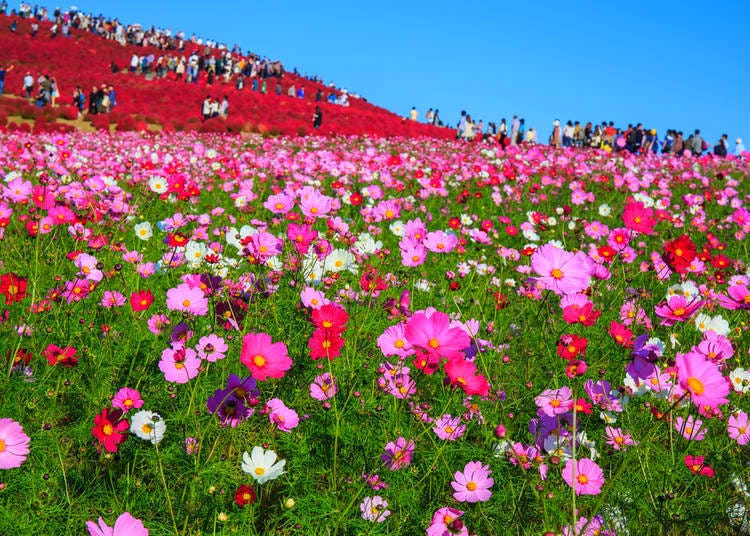
Cosmos flowers, celebrated as the "autumn cherry blossoms" or "akizakura" in Japan, are a quintessential part of the fall landscape. Known for their ease of cultivation and variety of colors, fields of cosmos can range in hue from golden to pink, enhancing the beauty of the autumn scenery. Throughout Japan, large swathes of cosmos are planted, making flower viewing a popular seasonal pastime. Numerous festivals and events dedicated to these vibrant autumn blooms are held across the country, celebrating their colorful display.
- Hitachi Seaside Park (Ibaraki Prefecture): A renowned flower destination, it transforms into a cosmos spectacle from early to mid-October, offering panoramic views of cosmos fields combined with red kochia.
- Showa Memorial Park (Tokyo): This expansive metropolitan park features large cosmos fields, becoming a vibrant tapestry of flowers during the blooming season, ideal for walks and photography.
- Kurihama Flower World (Kanagawa Prefecture): Celebrated for its impressive cosmos gardens, this park offers a variety of blooms in a spacious, family-friendly setting, perfect for flower lovers and families.
- Yamanakako Hananomiyako Park (Yamanashi Prefecture): Located near Lake Yamanaka, this park showcases vast fields of cosmos against Mount Fuji, with blooms in various colors from late August to mid-October.
- Sakura Furusato Hiroba (Chiba Prefecture): Known for its expansive cosmos fields, this park in Chiba provides a serene and picturesque environment, blending cosmos with traditional Japanese aesthetics.
- Yume Cosmos Garden (Kyoto Prefecture): A beautiful cosmos field in Kameoka featuring colorful blooms and a variety of events. Conveniently accessible from Kyoto Station, it's perfect for a quick visit.
- Expo '70 Commemorative Park (Osaka Prefecture): Centered around the iconic Tower of the Sun, it showcases over 300,000 cosmos plants of about 6 varieties from late September to early November, with the "Cosmos Festa" offering diverse events.
- Washigamine Cosmos Park (Wakayama Prefecture): At an altitude of 587 meters, it offers stunning views and about 1 million cosmos plants blooming from late September to early October, also known for beautiful sunsets.
Spider Lily (Manjushage) - Late September–Early October
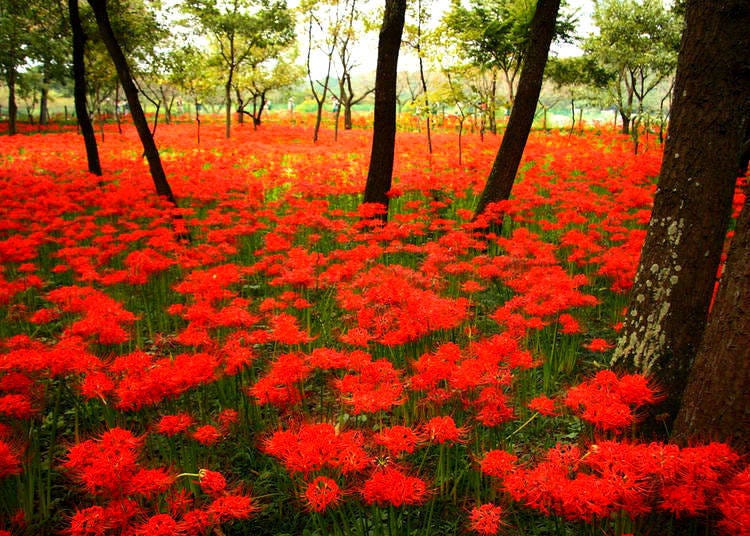
Manjushage, also known as red spider lilies or higanbana, are a distinctive and captivating flower that bloom in Japan from mid-September to early October. Noted for their vivid crimson red color and unique spider-like petals, these flowers are deeply embedded in Japanese culture. They bloom around the autumn equinox, coinciding with the significant Buddhist observance of O-Higan. Traditionally planted around gravesites, their poisonous bulbs served a practical purpose in deterring animals from disturbing graves, earning manjushage the monikers "death flower" or "corpse flower." The striking red color of the blooms, reminiscent of blood, has also linked them to themes of death and the afterlife in Japanese folklore, where they are sometimes seen as representations of spirits, with their fluttering petals likened to ghosts. Despite these somber associations, manjushage remains a cherished symbol of autumn, attracting many visitors to parks during their annual flowering season.
- Nyoirin-ji Temple (Iwate Prefecture): Located on the eastern hillsides of the Kitakami River, this temple adjoins the Omiyama ruins, a national historic site. In autumn, spider lilies bloom vibrantly along the approach and surrounding areas, creating a striking contrast against the vast blue skies.
- Kinchakuda (Saitama Prefecture): Famous for its spider lily fields, Kinchakuda is surrounded by the Koma River. During the blooming season, around five million spider lilies color the area in bright red. The Kinchakuda Manjushage Park hosts a festival featuring local cuisine, specialty products, and stage events.
- Oide River (Kanagawa Prefecture): Stretching about 3km, this river area between Chigasaki and Hiratsuka becomes a popular local spot for viewing tens of thousands of spider lilies. The Oide River Higanbana Festival celebrates the blooming season with various venues along the river displaying peak blossoms, including rare white, yellow, and pink spider lilies.
- Anao-ji Temple (Kyoto Prefecture): Part of the Western Kannon Pilgrimage and known for its beautiful garden, Anao-ji Temple is surrounded by fields where spider lilies bloom along the ridges, creating an enchanting scene with golden rice fields. It's a popular spot among photo creators, offering varying views from morning to evening.
- Katsuragi Hitokotonushi Shrine (Nara Prefecture): Known for its 1200-year-old ginkgo tree, this shrine offers pastoral scenes with spider lilies and rice fields. The area from the front of the shrine to the Kuhon-ji Temple surroundings provides a picturesque landscape of blooming spider lilies amidst the rice paddies.
Chrysanthemum (Kiku) - September–Mid-November
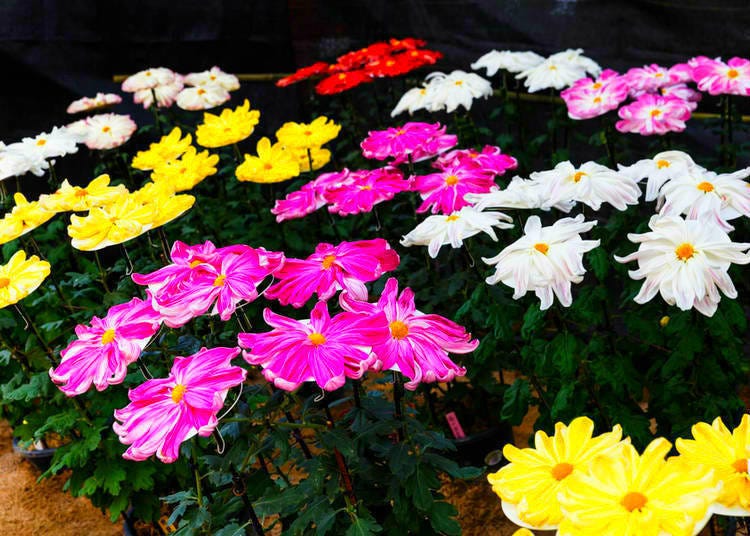
The chrysanthemum, or "kiku" in Japanese, holds a venerable status as Japan's national flower, a symbol deeply ingrained in its culture for centuries. Introduced from China in the 5th century, it quickly found favor with the Japanese imperial family and even appears on the front of the Japanese passport. In Japan, the chrysanthemum represents longevity, rejuvenation, and nobility, and is associated with autumn, the harvest season, and prosperity. A smaller variety of the chrysanthemum, resembling a dandelion, is commonly used as a garnish in sashimi dishes. In Yamagata Prefecture, the tradition of consuming this flower is present today, where people enjoy its petals boiled and served with soy sauce, pickled, or as tempura.
- Akabori Kogiku no Sato (Gunma Prefecture): In Isesaki City, this chrysanthemum field blooms with about 20,000 plants in mid-October. Volunteers maintain the colorful spectacle of pink, yellow, and white flowers.
- Yushima Tenjin Shrine Chrysanthemum Festival (Tokyo): Held every November in Bunkyo Ward, Tokyo, this festival at Yushima Tenmangu Shrine displays around 2,000 chrysanthemums. The site is known for its themed chrysanthemum dolls and special shrine seals.
- Kameido Tenjin Chrysanthemum Festival (Tokyo): This festival at Kameido Tenjin Shrine in Koto Ward showcases large chrysanthemums and a "Chrysanthemum Skytree." Celebrated for its photogenic displays, it's a must-visit for flower enthusiasts.
- Chrysanthemum Flower Beds Exhibition at Shinjuku Gyoen National Garden (Tokyo): In central Tokyo, Shinjuku Gyoen's Chrysanthemum Flower Beds Exhibition in November offers a glimpse of imperial-style chrysanthemum cultivation. Visitors can enjoy the harmony between the flowers and the garden.
- Chrysanthemum Exhibit at Sankeien Garden (Kanagawa Prefecture): Hosted in Yokohama's Sankeien Garden, this autumn exhibition features around 500 pots of various chrysanthemum styles, from traditional large blooms to delicate bonsai chrysanthemums.
- Yahiko Chrysanthemum Festival (Niigata Prefecture): At Yahiko Shrine, the November festival features about 4,000 chrysanthemum pots, with a focus on competitive quality and unique themes for its small chrysanthemum landscape flower beds.
Autumn Foliage (Koyo) - November–December
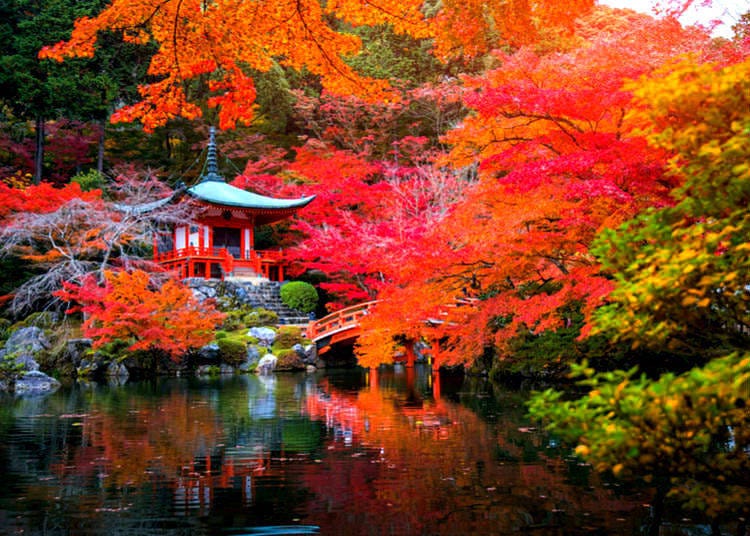
This isn’t a flower, but during the autumn visitors to Japan are given a real treat as the leaves turn different shades of red and yellow, it creates a really beautiful sight. They can be seen in cities and the countryside, basically anywhere there are trees!
Winter blooming flowers in Japan
During the winter months, Japan is home to a variety of flowers that blossom and bloom, adding color to the Japanese landscape.
Winter Peonies (Kan-Botan) - Late November–Mid-February
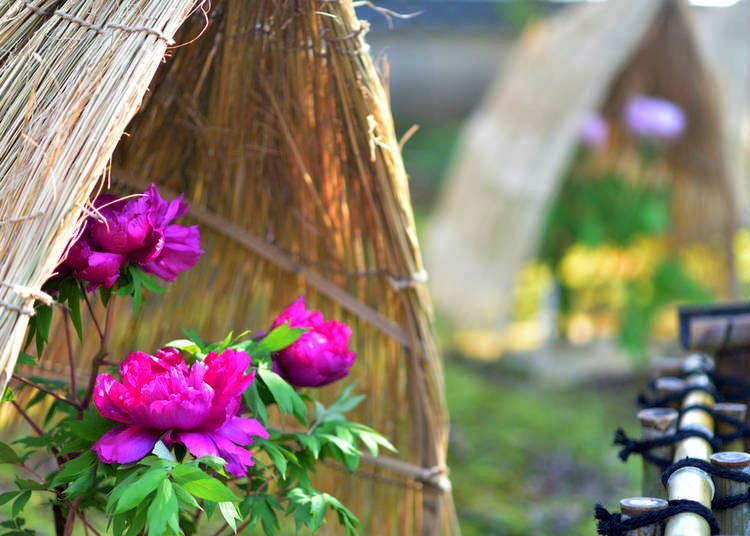
Winter typically isn't the season associated with blooming flowers, yet in Japan, the chilly months can still surprise you with vibrant blooms. Kan-botan, also known as Fuyu-botan, are a special variety of peonies that flourish in winter. These flowers, symbols of fertility and nobility, showcase their large, colorful petals from November to January. In regions where snow is common, these winter peonies are often sheltered with straw covers to protect them from the cold, ensuring their beauty can be admired even in the frostiest conditions.
- Hamarikyu Gardens (Tokyo): Located near Shimbashi Station, Hamarikyu Gardens is a serene spot where you can enjoy winter peonies amid traditional Japanese garden settings, offering a unique floral experience in the heart of Tokyo.
- Ueno Toshogu Shrine (Tokyo): Situated in Ueno Park, near Ueno Station, this shrine is a winter haven for peony lovers. The striking contrast of blooming peonies against the shrine's historic backdrop creates a picturesque scene.
- Soujiji Temple (Shiga Prefecture): Established by the Nara-era monk Gyoki, Soujiji is renowned for its peonies. Around 1,000 plants of 80 varieties bloom in the 20,000-square-meter precincts, adding color to the temple grounds from late April to early May.
- Kenninji Temple (Kyoto Prefecture): Known for its "Wind and Thunder Gods" painting by Tawaraya Sotatsu, this Rinzai Zen Buddhist temple, established in 1202, surrounds its Dharma Hall with peonies. Their bloom in late April to early May enhances the temple's charm.
- Otokuni-dera Temple (Kyoto Prefecture): Established by Prince Shotoku in the Asuka period, this temple is famous for its peonies, including 2,000 plants transferred from Hasedera Temple in Nara. The temple's scenic beauty is augmented by these blooming flowers in spring.
- Daisen Park Japanese Garden (Osaka Prefecture): Next to the World Heritage-listed Daisen Kofun, this garden hosts a peony exhibition from mid-April to mid-May. Various peony species, including some with unique two-toned petals, are cultivated here, offering a tranquil viewing experience.
-
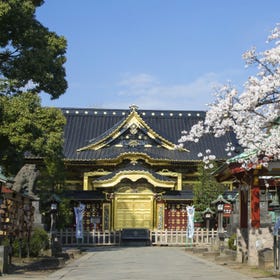
-
Address
9-88, Uenokouen, Taitou-ku, Tokyo, 110-0007
View Map -
Nearest Station
Ueno Station (Hokkaido Shinkansen Line / Tohoku Shinkansen Line / Akita Shinkansen Line / Yamagata Shinkansen Line / Joetsu Shinkansen Line / Hokuriku Shinkansen Line / JR Keihin-Tohoku Line / JR Yamanote Line / JR Tohoku Main Line / JR Utsunomiya Line / JR Takasaki Line / JR Joban Line / JR Ueno Tokyo Line / Tokyo Metro Ginza Line / Tokyo Metro Hibiya Line)
5 minutes on foot
- Phone Number 03-3822-3455
-
Address
9-88, Uenokouen, Taitou-ku, Tokyo, 110-0007
Japanese Daffodils (Suisen) - December–January
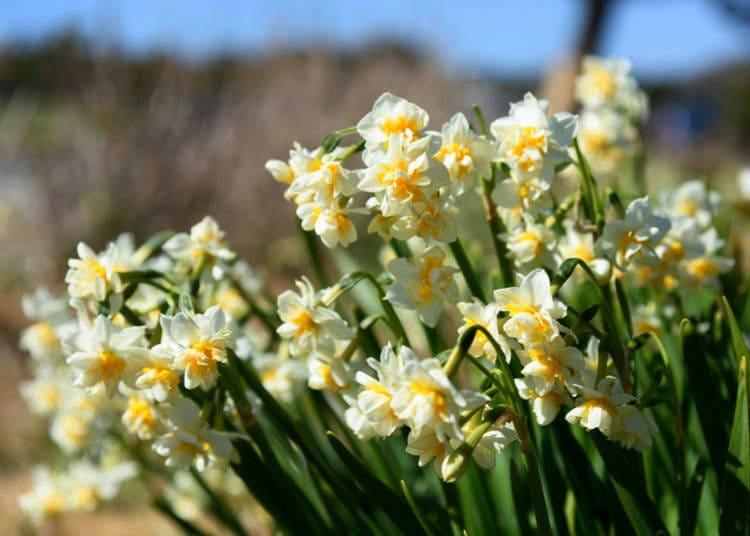
The Japanese narcissus, known locally as suisen, is one of the common daffodil varieties in Japan. These flowers are distinguished by their delicate white and yellow blooms, which are smaller than those of other daffodil types. Blooming from December to January, the suisen offers a delightful sight of flowering daffodils even during the colder months.
- Takino Suzuran Hillside National Park (Hokkaido): This expansive 400-hectare national park in Sapporo showcases over 800 flower species, including vibrant daffodils, in its Country Garden. It's a picturesque destination for flower enthusiasts.
- Ezuki Suisen Road (Chiba Prefecture): As one of Japan's three major daffodil sites, this scenic path offers a 30-40 minute hike surrounded by millions of blooming daffodils, making it a must-visit for nature lovers.
- Kasai Rinkai Park (Tokyo): Tokyo's largest metropolitan park features an aquarium, a giant Ferris wheel, and Daffodil Road. The annual Narcissus Festival celebrates the bloom of around 200,000 daffodils in February.
- Nabana no Sato (Mie Prefecture): Located in Kuwana City, this extensive floral theme park includes botanical gardens and hot springs. The Narcissus Festival showcases around 20,000 daffodils, accompanied by seasonal illuminations.
- Tachikawa Narcissus Garden (Hyogo Prefecture): This 6-hectare area in Sumoto City is home to about 4 million daffodils, offering a breathtaking view.
Love Japanese flowers? Book a flower tour or experience!
-
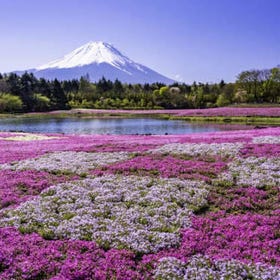 Mt Fuji flower Instagrammable spots Gotemba outlet/hot spring tour
Mt Fuji flower Instagrammable spots Gotemba outlet/hot spring tour -
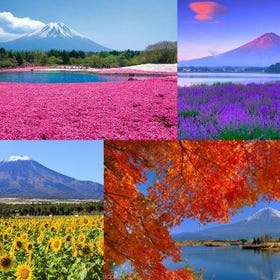 Mt. Fuji Flower Festival Tour with Mt. Kachi Kachi Ropeway Experience from Tokyo
Mt. Fuji Flower Festival Tour with Mt. Kachi Kachi Ropeway Experience from Tokyo -
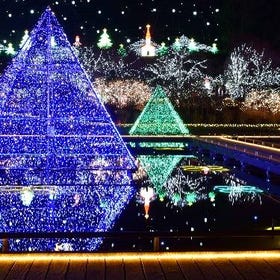 Strawberry Picking, All-You-Can-Eat-Crab and Ashikaga Flower Park/Lake Sagami Light Show from Tokyo
Strawberry Picking, All-You-Can-Eat-Crab and Ashikaga Flower Park/Lake Sagami Light Show from Tokyo -
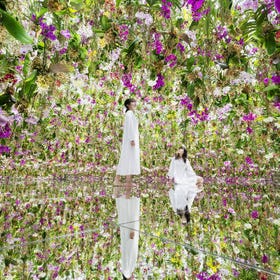 teamLab Planets TOKYO DMM Admission Ticket
teamLab Planets TOKYO DMM Admission Ticket -
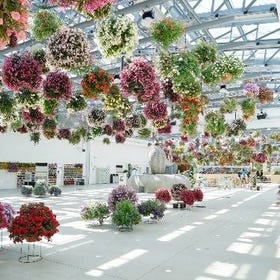 "HANA・BIYORI" A New Sensation Flower Park Ticket in Tokyo
"HANA・BIYORI" A New Sensation Flower Park Ticket in Tokyo -
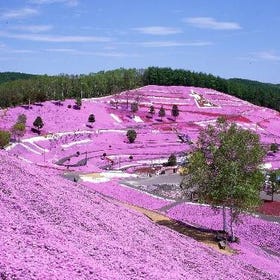 2-day tour of three flower fields in eastern Hokkaido
2-day tour of three flower fields in eastern Hokkaido
- Category
*Prices and options mentioned are subject to change.
*Unless stated otherwise, all prices include tax.
Limited time offer: 10% discount coupons available now!
Recommended places for you
-
Menu
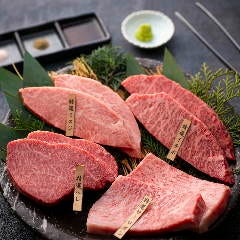
ISHIDAYA Hanare
Yakiniku
Kobe, Sannomiya, Kitano
-
Appealing

Rukku and Uohei
Izakaya
Sapporo / Chitose
-

Kamesushi Sohonten
Sushi
Umeda, Osaka Station, Kitashinchi
-
Goods

Yoshida Gennojo-Roho Kyoto Buddhist Altars
Gift Shops
Nijo Castle, Kyoto Imperial Palace
-
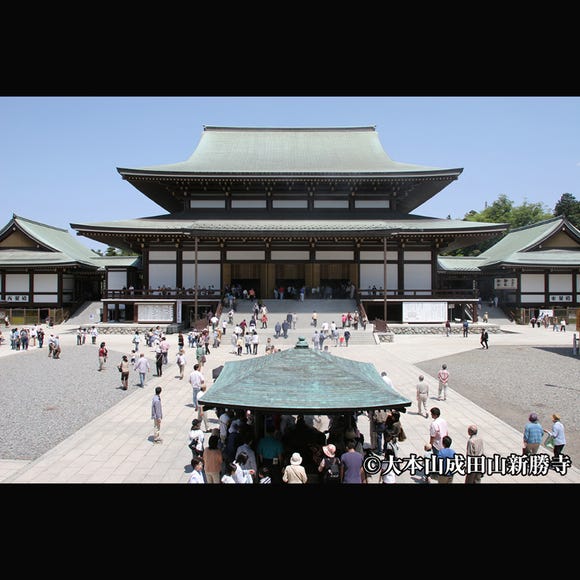
Naritasan Shinshoji Temple
Temples
Narita
-

Jukuseiniku-to Namamottsuarera Nikubaru Italian Nikutaria Sannomiya
Izakaya
Kobe, Sannomiya, Kitano
-

Discover Osaka Station City: A Journey Through Its Most Fascinating Spots
-

Step Into the Story: Inside Immersive Fort Tokyo
-

The CASIO S100: How CASIO's Masterpiece Calculator Redefines Business Elegance With Japan-Made Reliability
-

Professional Photos Even Beginners Can Shoot! 10 Tips for Taking Stunning Cherry Blossom Photos
-

15 Must-Try Restaurants in Ikebukuro: From Aged Yakiniku to All-You-Can-Eat Sushi, Plus Adorable Animal Cafés
-

15 Must-Try Sushi Restaurants in Tokyo (+5 Trending Areas to Explore for Foodies)
-

8 Unfamiliar (But Totally Normal) Customs in Japan!
-

Otaru Travel Guide: Inside Hokkaido's Leading Destination (Sightseeing, Food, and Shopping Tips)
-
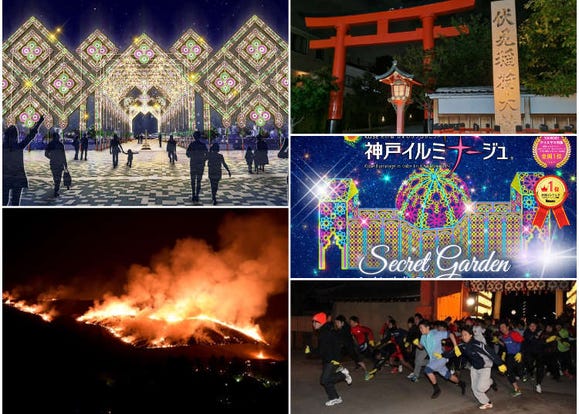
What to Do in Osaka & Kyoto in January 2024: Experience Japanese New Year Traditions
-

10 Incredible Experiences to Enjoy in Niseko According to 5 Foreign Residents!
-

Japanese countryside town makes giant corn maze full of oni for summer
-
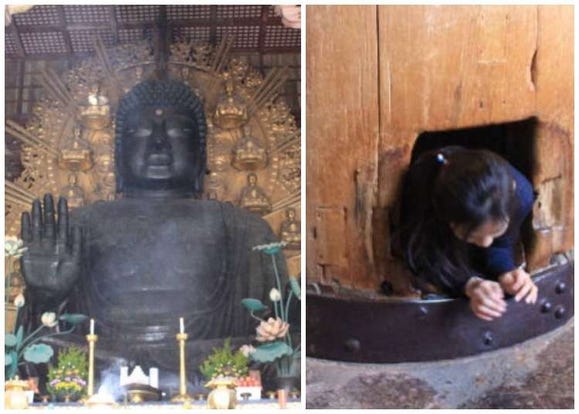
Todai-ji Temple: Home to the Great Buddha of Nara - And a Nose Hole That Brings You Luck!?
- #best sushi japan
- #what to do in odaiba
- #what to bring to japan
- #new years in tokyo
- #best ramen japan
- #what to buy in ameyoko
- #japanese nail trends
- #things to do japan
- #onsen tattoo friendly tokyo
- #daiso
- #best coffee japan
- #best japanese soft drinks
- #best yakiniku japan
- #japanese fashion culture
- #japanese convenience store snacks














